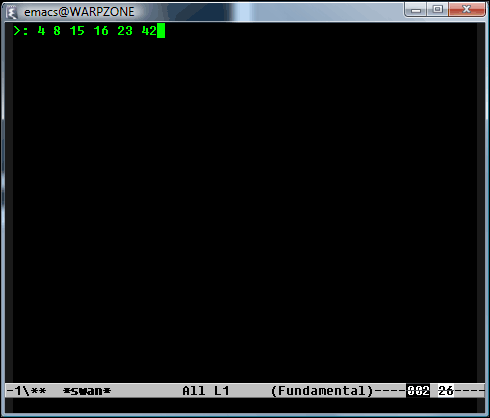u
p
d
a
t
e |
emacs lost-mode
(07 Jun 2008 at 00:31) |
Spoiler alert! This emacs mode contains spoilers for the TV show Lost (Season 2). (I always wanted to say that, heh heh.) It will also make no sense to anyone who hasn't seen the show or used emacs.
Now that Lost Season 4 is over, I know you need something to tide you over for 9 months or whatever until it comes back. Therefore please enjoy this emacs mode simulating the Swan station computer from Lost. The modeline countdown timer will follow you in every buffer, ticking down the seconds.

When reaching the 4 minute mark, you can use the Swan computer and do what you gotta do:

If you don't do what you gotta do, then you might get some System Failure:

System Failure used to kill emacs without saving your buffers, but I decided this was a bit too cruel. Now you can live with System Failure indefinitely, meaning that you can safely run lost-mode as part of your regular day-to-day emacs use. If you have emacs I recommend trying it yourself so you can see the animations (particularly the timer reset animation). Put
lost.el
in a place where you like to store your emacs files (say, "/home/desmond/elisp") and then add
(load "/home/desmond/elisp/lost.el")
to your .emacs file (or the equivalent for your platform; don't forget to escape backslashes on win32). The mode is then activated on startup and cannot be disabled. |
 |
 |
My simulated Dharma Intiative breaks from coq hacking have been very satisfying.
I almost wish it did destroy all my buffers - then I'd be afraid to fool around.
Or maybe I'd just play emacs tetris instead of reading blogs. |
| Sweet. This is a very important mode. Once Unicode 5.2 is released, and once Unicode is working correctly in Emacs, you'll be able to represent the hieroglyphics more accurately. |
| Yeah, I'm not holding my breath for good Unicode support in emacs, but I was mildly sad that I had to settle for some conservative "weird" glyphs that are likely to be in your fonts. Patches absolutely welcome. |
| Ok great. One minor issue, the button is "pushed" not "pressed" |
| Ah, thank you. Fixed. |
| Someday, far in the future: 𓋳𓏪𓍑𓅀𓏩 |
That didn't work.
Unicode test: I like Pittsburgh, because I need my ☂. |
| Bah! |
| Of course I am escaping the ampersand, but you can probably paste UTF-8 right into this textbox? |
| Nope, that's what I did. |
| Really? This is mysterious indeed... |
| I ♡ heartsuit |
| Wow, you're right, but I don't remember ever writing this code. |
Tom 7: you didn't write it. The comment form doesn't have the encoding explicitly specified so the browser assumes it's the same as the encoding of the html where that form is. As that encoding isn't specified either (by the http response header nor meta tags in the html), browsers typically assume it's cp-1252 (but lies and says iso-8859-1) unless you've configured them to something different which people did do back in the days when lots of people put up webpages with national characters without specifying the encoding. Anyway, this means you can type 8859-1 characters (áéíóÁÉÍÓ) in the comment form but if you type anything else (őűŐŰ…–“„”) the browser will still use 8859-1 encoding to submit the form and all bets are off what it will do. Mozilla variants are known to silently convert other characters to ampersand-escapes; whereas links converts them to flying accents but tries not to allow you to enter them in the form at first place.
|
| Thanks jonas! I began suspecting something like this after I made that last post. I'll look into specifying an encoding. |
| I think all the encoding stuff is finally straightened out, btw. |
| activity rays dimming |
It´s good, but it´s not great:)
I have a better version:) |
 |
|
|